As the American's had actually done to the cities of Hiroshima and Nagasaki in August 1945. Tanaka, Honda and Tsuburaya's allegorical living Atomic Weapon leveled the Japanese capital city of Tokyo. The motion picture fueled terrible memories for many Japanese about how World War 2 ended for Imperial Japan. Because of the political aspect of the film. The story had to be reworked and new footage added in 1956 for the United States.
Next the artistic duo of Honda and Tsuburaya were given the task, by Tanaka, of creating "Ju Jin Yuki Otoko (Beast Man Snow Man aka: Mountain Snowman)" in 1955. He followed that, in 1956, by having the duo create two giant Pteranodon's. They were given the name "RADON" and in 1957 the English language World saw that name transposed to "RODAN"! As audiences watched the mates destroy the World's cities
By 1957 Studio Chief Tomoyuki Tanaka decided to move away from Kaiju, at least for the team of Ishiro Honda and Eiji Tsuburaya, and enter Outer Space Science Fiction. Which was a major product of the minor studios in the United States for years and had gained some footing in the United Kingdom as well. My article starts with the first major production in Tanaka's change of direction.
CHIKYU BOEIGUN (EARTH DEFENSE FORCE)
According to Steve Ryfle and Ed Godiszewski in their 2017 work "Ishiro Honda: A Life in Film, from Godzilla to Kurosawa". Honda said the following about the production of "Chikyu Boeigun"being:
larger in scale compared to Godzilla or Rodan and is aimed to be more of a true science fiction film... I would like to wipe away the [Cold War-era] notion of East versus West and convey a simple, universal aspiration for peace, the coming together of all humankind as one to create a peaceful society.Tomoyuki Tanaka hired Jojiro Okami aka: Jotaro Okami, an aeronautical military engineer and, at the time, budding Science Fiction writer, to create the story. Okami would create the stories for 1962's " Yosei Gorasu (Ominous Star Gorath)" and 1964's "Uchu Daikakaiju Dogora (Universe big monster Dogora)". There is another one which I will address after this picture.
Tanaka had Takeshi Kimura turn that story into a screenplay. Kimura was a member of the Japanese Communist Party and his screenplays typically included political themes. He was the screenplay writer for "Sora no Daikaiju Radon (Radon: Giant Monster of the Sky)", "Kaiju Soshingeki (Total Monster Advancement aka: Destroy All Monsters)","Matango", "Furankenshutain tai Baragon (Frankenstein vs the Subterranean Monster Baragon)", its sequel "Furankenshutain no Kaiju: Sanda tai Gaira (Frankenstein's Monsters: Sanda vs Gaira") and "Kingu Kongu no Gyakushu (King Kong's Counter Attack aka: King Kong Escapes)".
The screenplay, as was also happening with movies in the United States at the time like "Forbidden Planet", was adapted into a short story for publication by author Shigeru Kayma.
As an indication of how much value Toho Studio's placed upon this production. This would be the fourth motion picture in TohoScope. An anamorphic lenses system similar to 20th Century Fox's CinemaScope and the first Tokusatsu (Special Effects) motion picture in that process.
The musical score was by Toho's great composer Akira Ifukube. Who among other works created the recognizable theme for "Gojira" and other recurring themes for the military attacks used through the Showa Era Kaiju and Science Fiction films. Besides contemporary Orchestral and Chamber music.
"Chikyu Boeigun" was released in Japan on December 28, 1957.
The cast was headed by:
Kenji Sahara as Scientist "Joji Atsumi". In "Gojira" his role was described as "Young Lover on the sound:" while in "Godzilla, King of the Monsters" it was changed to "Man on the boat". He was the male lead "Shigeru Kawamura" in "Sora no Daikaiju Radon"
Yumi Shirakawa was "Etsuko Shiraishi" the girlfriend of "Joji". Her only previous work was "Sora no Daikaiju Radon" in the role of "Kiyo" the girl friend of "Shigeru".
Momoko Kochi was "Hiroko Iwamoto". The actress was "Emiko Yamane" in Honda and Tsuburaya's "Gojira" and "Machiko Takeno" in their "Ju Jin Yuki Otoko".
Akihiko Hirata was Scientist "Ryoichi Shiraishi". Probably his most famous role was that of the tortured "Dr. Daisuke Serazawa" in "Gojira". Hirata had the recurring role of "Seijuro Yoshioka" in Hiroshi Inagaki's masterful classic "Samurai Trilogy" starring Toshiro Mifune. He was in many of Ishiro Honda's films including "Sora no Daikaiju Radon", "Bijo To Ekatai-Ningen (Beauty and the Liquid Men aka: The H-Man)" and "Mosura (Mothra)", Along with Toho features such as"Denso Ningen (The Electrically Transmitted Man aka: The Secret of the Telegram)" and the excellent story of Pearl Harbor and Midway from the Japanese perspective "Hawi Middouei daikaikusen: Taiheiiyo no arashi (Hawaii-Midway Battle of the Sea and Sky: Storm in the Pacific Ocean) aka: Storm Over the Pacific".
Takashi Shimura portrayed "Dr. Kenjiro Adachi".He was the lead actor in four classic motion pictures by Director Akira Kurosawa. They were 1948's "Yidore Tenshi (Dirty Witch Angel aka: Drunken Angel)", 1950's "Rashomon" both co-starring Toshiro Mifune, 1952's "Ikiru (To Live)" and 1954's "Shichinin no Samurai (Seven Samurai) again with Mifune. Also in 1954 he portrayed "Dr. Kyohei Yamane" in "Gojira" and repeated the role in the first sequel to the film among his 272 feature film credits.
The original Toho version of "Chikyu Boeigun" had a running time of 88 minutes.

"Joji", "Etsuko", her brother "Ryoichi", and his girlfriend "Hiroko", are at a small village enjoying a festival. When a fire breaks out in the woods, and the two men, with some of the villagers, go to see it. Looking at the fire, it is obvious that it is burning, strangely, from under the ground, at the roots of the trees, but why and how becomes an unanswered question? As the fire spreads, it kills some of the villagers, and "Ryoichi" disappears. The other three believe he lost his life in the fire.
"Joji" goes to the local observatory to meet with his and "Ryoichi's" mentor, and head astronomer, "Dr, Kenjiro Adachi". "Astusmi" tells the doctor about the incident in the village and "Shirashi's" disappearance. He also hands him an unfinished report from his friend. The report theorizes that between Mars and Jupiter there had been another planet that was somehow destroyed. "Ryoichi Shirashi" has named it, "Mysteroid Planet #5". While the two men discuss the feasibility of such a planet having existed, the phone rings. They are informed that the village "Joji" and "Ryoichi" were at with their girl friends, has been destroyed by an Earthquake of unknown origin.

"Joji Atsumi", becomes part of the investigation team on the village's destruction. He is driven to the village's site with the head of the Fuji Police Force and another Scientist to meet with other investigators and the military.
"Joji" goes to the local observatory to meet with his and "Ryoichi's" mentor, and head astronomer, "Dr, Kenjiro Adachi". "Astusmi" tells the doctor about the incident in the village and "Shirashi's" disappearance. He also hands him an unfinished report from his friend. The report theorizes that between Mars and Jupiter there had been another planet that was somehow destroyed. "Ryoichi Shirashi" has named it, "Mysteroid Planet #5". While the two men discuss the feasibility of such a planet having existed, the phone rings. They are informed that the village "Joji" and "Ryoichi" were at with their girl friends, has been destroyed by an Earthquake of unknown origin.

"Joji Atsumi", becomes part of the investigation team on the village's destruction. He is driven to the village's site with the head of the Fuji Police Force and another Scientist to meet with other investigators and the military.
They find a large group working at the site of a destroyed shine. "Joji" is told that the shine's location means that the village was further uphill and should be mainly untouched, but it's completely gone. "Atsumi" learns that after the Earthquake, radiation was picked up on Geiger Counters, but the radiation readings disappeared within hours. Now, dead fish are seen flowing downstream and he accompanies members of the Fuji Police Force to another location to investigate the cause.

As the men continue to discuss the situation, the Geiger Counter starts to record a sudden radiation increase, and a mountainside starts to falls in front of them. Out of the falling debris steps a giant insect looking robot, that attacks, killing all, but "Atsumi" and the lead Fuji Police Officer.


The robot is called a "Moguera", but not in this motion picture. That name will become an acronym "M.O.G.U.E.R.A.", and be used in the 1994 Hesei Era motion picture, "Gojira tai SupesuGojira (Godzilla vs Space Godzilla). In that film the acronym stands for "Mobile Operations G-Force Universal Expert Robot Aero-Type", and the dialogue will indicate, in the original Japanese language version, that it was reverse engineered from Alien technology, implying "The Mysterians".

As the men continue to discuss the situation, the Geiger Counter starts to record a sudden radiation increase, and a mountainside starts to falls in front of them. Out of the falling debris steps a giant insect looking robot, that attacks, killing all, but "Atsumi" and the lead Fuji Police Officer.


The robot is called a "Moguera", but not in this motion picture. That name will become an acronym "M.O.G.U.E.R.A.", and be used in the 1994 Hesei Era motion picture, "Gojira tai SupesuGojira (Godzilla vs Space Godzilla). In that film the acronym stands for "Mobile Operations G-Force Universal Expert Robot Aero-Type", and the dialogue will indicate, in the original Japanese language version, that it was reverse engineered from Alien technology, implying "The Mysterians".
The robotic machine advances toward a town near the Koyama Bridge and engages the military at night.
.jpg)
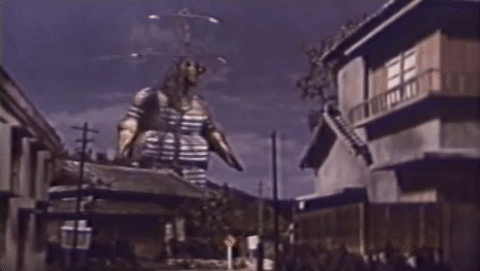
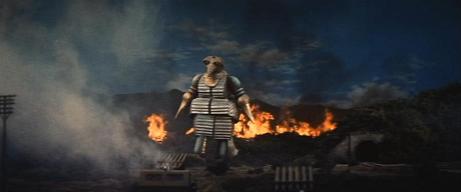
Conventional weapons have no effect on the robot, but as it starts across the bridge. The bridge is blown up and the alien robot damaged. "Joji Atsumi" reports his findings to "Dr. Adachi", and the political and military officials at the "National Diet Building". In his report, "Joji" states the robot was constructed out of some chemical material not found on Earth. Later, "Dr. Adachi" and his assistant at the observatory photograph activity around the moon.
"Dr. Adachi" takes a group of scientists including "Joji Adachi", accompanied by the military, to a lake. That in "Ryoichi Shirachi's" unfinished "Mysteroid" report, he states is a base for flying saucer operations on Earth.
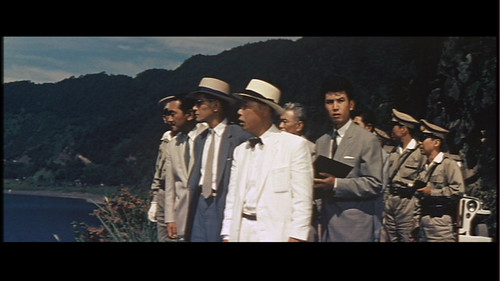
As the group looks at the lake, in another direction the land starts to be whipped up, and a Dome structure raises from under the ground.

Suddenly a voice speaks from inside the Dome asking to see Five Specific people. How did the voice know their names? The Five, including "Atsumi" and "Dr. Adachi", enter the Domed structure and are told to put on capes for warmth. There they meet the leaders of "The Mysterians".
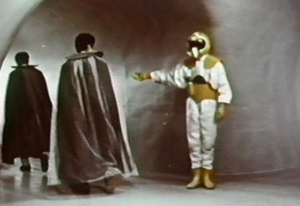
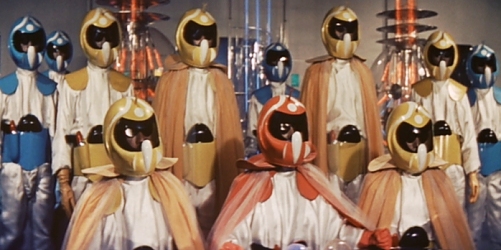

The leader confirms that they are from"Ryoichi's" 5th Planet, and explains that it was destroyed by Atomic War 100,000 Earth years ago. At which time some of survivors escaped to Mars. However, the men and women survivors discovered problems with their birth rate, because of Strontium 90 within their bodies. However, the "Mysterian" leader tells the five men they have the simple plan of mating with Earth women to save their dying race.
Adding that there are five specific women they want to begin with. He then shocks the five Earth men by stating they have already acquired three, but still want "Etsuko" and "Hiroko". Again raising the question how did they get their names?
That answer comes later. As "Joji" meets the two women, explains the aliens plans, and that the house in now under police guard. As the three continue to talk, from the turned on television set, the voice of "Ryoichi" is heard. The three turn and "Ryoichi" appears on it, both alive and well, but in the domed base of operations of "The Mysterians".

He tells "Atsumi" that if he just turns on a television set anywhere, he will appear. An emergency meeting with the military, the Prime Minister and others is called. Prior to the meeting, "Atsumi" had told "Dr. Adachi" about "Ryochi". At the meeting, the two turn a television set on and those present are told by "Ryochi", that their plans of battling the invaders is futile. "Ryoichi Shirashi" explains that the flying saucers operate from a Moon Base and a giant Space Station circling the Earth.
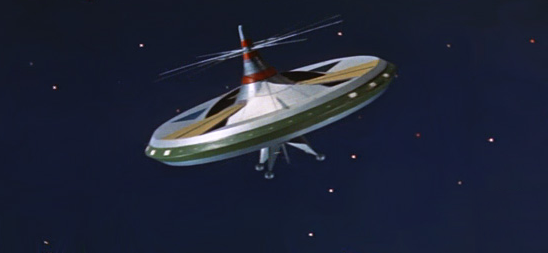
The battle begins.
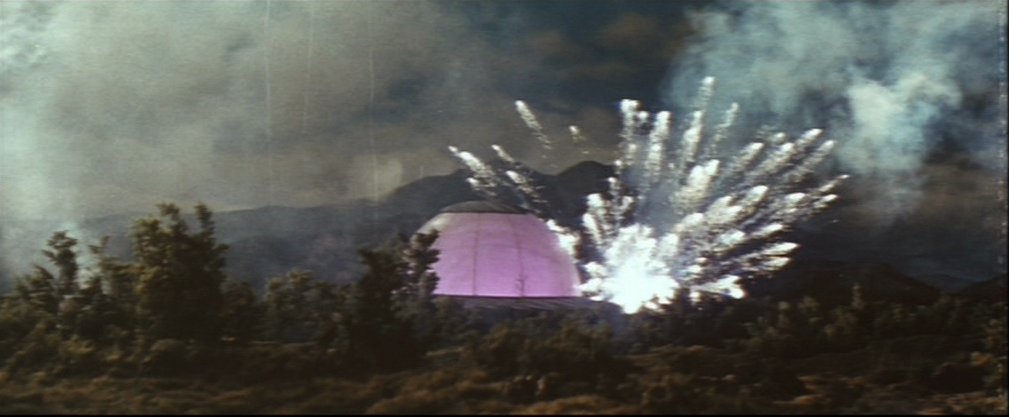
Meanwhile, flying saucers appear over the house where the two women are staying under guard, but they are still are able to be kidnapped. The battle with the invaders is going against the military, because conventional weapons are ineffective against the advance technology of the aliens.
Japanese Scientists develop plans for building giant warships called "Alpha" and "Beta", but they need the World's help. All the countries of the Earth send their scientists to Japan, as the invaders demand to increase the size of the land they had originally wanted.
Along with the two warships, other electronic weapons are created, and mankind's final battle against "The Mysterians" starts.

By accident, "Atsumi" discovers an entrance, through an air duct in the ground, to the alien base and enters it to rescue the women. There he will meet with, and discover that, "Ryoichi Shiraishi" has realized the truth about the "Mysterians", and will help him destroy the base.

The actual ending is interesting as the defeated "Mysterians" are seen leaving Earth for their space station. "Etsuko" asks "Joji" will they return and he tells her the Earth will be ready. As the screenplay leaves the story open ended.
On May 15, 1959 "Chikyu Boeigun" was released in the United States as "The Mysterians".
_001.jpg)
Note that the above poster says "M-G-M PRESTENTS". The English language dub of Ishiro Honda's "Chikyu Boeigun" as "The Mysterians" almost wasn't released at all.
RKO Pictures purchased the rights to the Toho production and paid for the dubbing. However, that studio was about to go belly up and sold the film to "Loew's Incorporated" the current parent company of the also failing studio Metro-Goldwyn-Meyer. Even the majors were feeling the power of television and rising costs of production. According to M.G.M. records after all expenses were covered the picture showed a profit on only $58,000 in the United States. Also many of the original release prints of the English language dub opened with:

The motion picture was more successful in Foreign Markets were the English language version was called "Earth Defense Force" without the added "S", but the subtitled versions had such titles as:
West Germany

Norway:
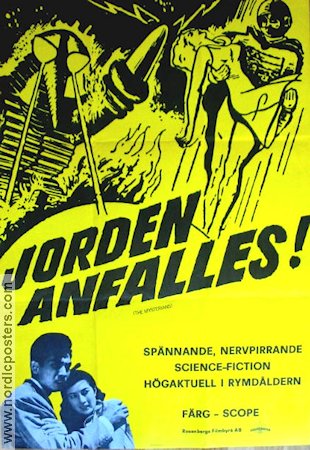
UCHU DAISENSO ( SPACE WAR)
Once more the team of Director Ishiro Honda and Special Effects Ace Eiji Tsuburaya were given a Science Fiction film by Producer Tomoyuki Tanaka. Once again the story was written by Jojiro Okami. The musical score was composed by Akira Ifutube.
The difference came with the screenplay being written by Shininchi Sekizawa. He had been the Producer, Director and Writer of a Science Fiction film in 1956 entitled Soratobu enban kyofu no shugeki (The Fearful Attack of the Flying Saucers)". Some sources list a cast and a running time of one hour and twenty minutes and other sources state the film was cancelled before it started filming. Either way it is a mystery as no photographic evidence of the picture seems to exist today. Among Sekizawa's Toho writing credits would be "Mosura (Mothra)", "Kingu KonguTai Gojira (King Kong vs Godzilla)", "Kaitei Gunkan (Undersea Warship aka: Atragon)" and "Sandai Kaiju: Chikyu Saidai no Kessen (The Three Great Monsters: The Greatest Decisive Battle on Earth aka: Ghidrah, the Three Headed Monster)".
"Uchu Daisenso" was released in Japan on December 26, 1959.

The cast was headed by:
Ryo Ikebe as "Major Ichiro Katsumiya". Ikebe had been acting since 1942 and had appeared is several War films and other dramas. He is best known for a Japanese/Chinese co-production in 1956 translated as "Madame White Snake". It's about a man who falls in love with a Chinese Snake Goddess in Human form. Ikebe was also in the previously mention "Storm Over the Pacific" among other Toho Productions including the last film I will mention in this article.
Kyoko Anzai now portrayed "Etsuko Shirashi". She had been acting since 1953 and after one more picture she would retire with 26 on screen credits. In this picture the character either referred too as "Etsuko", or "Shirashi" is in love with "Katsumiya". There is no mention of "Joji Atsumi", or if she was the sister of "Ryoichi Shiraishi".
Koreya Senda was now "Professor Adachi". He had been acting since 1928, but World War 2 stopped that until 1947. In 1958 Senda portrayed "Dr, Maki" in "Bijo To Ekatai-Ningen (Beauty and the Liquid Men aka: The H-Man)", the same year he was "Dr. Sugimoto" in "Daikaiju Baran". Which was both a feature length motion picture from Toho and a re-edited with some additional footage. In to a Japanese television version by Toho. The American company Crown International mutilated the picture into "Varan, the Unbelievable" with added American footage. The following year Koreya Senda was in the true story "Daigo Fukuyu-Maru (Lucky Dragon #5)" about the incident that inspired Tomoyuki Tanaka to make "Gojira". In 1970 Senda portrayed "Prince Fumimaro Konoye" in "Tora, Tora, Tora!".
Minoru Takada portrayed the role simply stated as "The Commander". He had begun his acting career in 1924 and ended it in 1971 with 161 on screen credits. He had three other roles my reader should be familiar with in:"Sekai daisenso (The Last War)", "Kaitei Gunkan (Undersea Warship aka: Atragon)" and "Sandai Kaiju: Chikyu Saidai no Kessen (The Three Great Monsters: The Greatest Decisive Battle on Earth aka: Ghidrah, the Three Headed Monster)".
Len Stanford was "Dr. Roger Richardson". I could not locate any more information than he was in this motion picture. As with Linda Miller the "Ann Darrow" of "Kingu Kongu no Gyakushu (King Kong's Counter Attack aka: King Kong Escapes)". Who was an American model who happened to fit the requirement for her role. Toho may have found American Len Stanford and offered him a one time motion picture role as they needed an American lead.
The original Toho version of "Uchu Daisenso" had a running time of 93 minutes.

THE PLOT
The movie opens with a view of a space station and the crew making the normal contact with "Space Command".

With a title card the audience has been told that the year is 1965.
The date is important for two reasons. The first is the date informs the viewer, in 1959 Japan, how little into their future the events are suppose to be taking place. This is a gimmick used in many American Space oriented Science Fiction movies of the period.The second reason is that this film, as two of the characters mentioned above would indicate, is in some ways a sequel to 1957's "Chikyu Boeigun", but with events taking place eight years after that original feature.
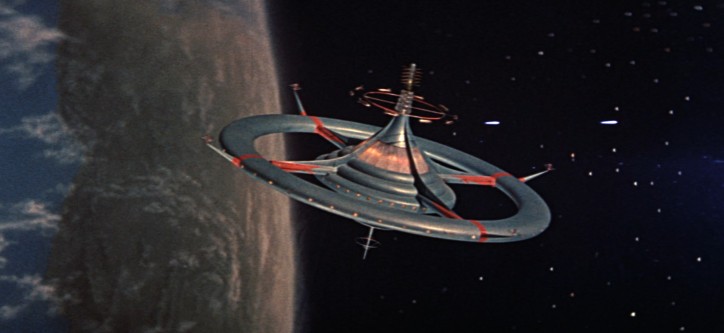
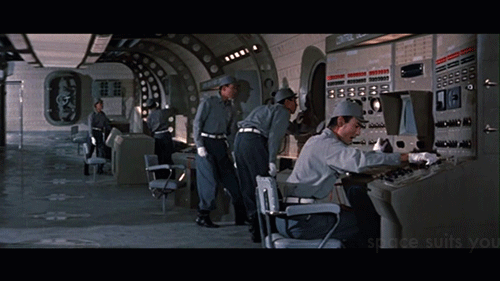
Suddenly the space station is attacked by flying saucers aiming meteorite like bombs at it. The station is destroyed and the titles for the motion picture begin.
A railroad employee is inspecting the rails with a lantern as he crosses a bridge. Suddenly there is a high pitch sound and he falls withering in pain. As the employee watches the lantern rises from the ground and then the entire bridge is lifted into the air. Followed by a speeding training going over the now open gorge. Next the railroad worker watches the bridge replaced, almost, as if nothing ever happened.
Through World Wide television news it is reported that an ocean liner was lifted completely out of the Panama Canal and that there was, also, severe unnatural flooding in Venice, Italy. Add to it the two previous incidents I mentioned and the United Nations calls a special meeting at the Japanese Space Center.
The meeting is conducted by "Major Katsumiya", "Professor Adachi" and "Dr. Richardson". "Richardson" tells the assembled representatives that in every case the survivors had severe frostbite. His theory is that someone can lower the temperature of any object. Thereby, lowering the Earth's gravitational pull on the object in question. While "Katsumiya" states this force has to come from Outer Space.
Below "Major Katsumiya" reads his findings.

"Dr, Richardson" addresses the meeting.

During their report the Iranian delegate, "Dr. Ahmed", suddenly develops severe headaches, gets up and just walks out of the meeting. "Etsuko Shirashi" while working observes "Dr. Ahmed" being engulfed by a red ray and disappear.

At an another location "Professor Adachi" and ""Major Katsumiya" are demonstrating, for the International Scientists, a new heat ray gun that the Space Center has developed

"Dr. Ahmed" walks into the group to destroy the heat ray. He grabs "Etsuko" as he gives a warning that the Earth will become a colony of the unknown planet "Natarl".

He is shot in his gun arm and escapes with everyone following. As they watched a flying saucer appears and disintegrates "Ahmed". Examining the remains a tiny radio control transmitter is discovered.
It is next confirmed that the flying saucers are coming from a base on the Moon. As the Space Center's newly developed space craft are about completed. A decision is made to send the two space ships, carrying eight crew members in each, to the Moon. One crew will be under the leadership of "Professor Adachi" and the other "Dr. Richardson".
Before the ships are launched. One of the crewman,"Iwamura", decides to go to the Ginza to relax. On his way a flying saucer comes over his car and an operation is performed. As with "Dr. Ahmed", "Iwamura", becomes a "Robot" of the planet "Natarl".

To a strong military send off the two space craft are launched towards the Moon.

On the way flying saucers attack with the same meteor bombs used against the space station.They are stopped, but "Iwamura" attempts to stop the crew on his ship. He is knocked out and tied up. The two ships touch down on the face of the Moon and the crewman remaining on "Professor Adachi's" ship is warned to watch "Iwamura".

+Uchu+Daisenso+10.jpg)
The remaining crews of both ships get into special vehicles that can ride on air jets and have armament. They head in the direction of the alien Moon base.



The "Natral" Moon Base is discovered and "Etsuko Shirashi" is sent to get the heat ray gun brought up.

On her way "Etsuko" is attacked by the aliens, but she is rescued by "Ichiro Katsumiya".

With the heat ray gun in place the attack on the Moon Base commences.


While this is happening "Iwamura" has escaped, knocked out the other crewman and blown up one of the two space ships. He is proceeding to the second space craft/ When the Moon Base is destroyed and control over him is lost. Regaining his senses "Iwamura" arms himself to fight the aliens.
As the two hover craft move back to the space ships they are attacked by flying saucers.

One of the two is damaged and the two crews combine in the remaining hover craft. Arriving at the landing site they discover the destroyed ship. "Iwamura" yells at them:

"Iwamura" apologizes for the destruction and will stay to hold off the flying saucers until the others escape. Just as the remaining space ship lifts off he is killed.
Returning to Earth all the World's countries join forces to create combat the alien space craft for the final battle with Natral. The battle comes both on Earth and in Outer Space.




The battle concludes with a confrontation with the alien mother ship
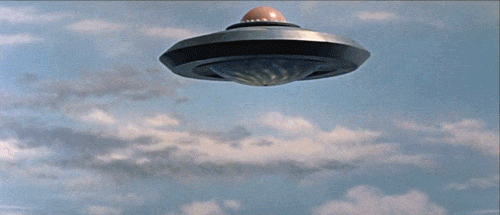

The ship is destroyed along with the last of the flying saucers. The war with "Natral", as with the war with "The Mysterians", concludes with congratulations and an open ended warning to be watchful.
On July 8, 1960 "Uchu Daisenso" was released in the United States as "Battle in Outer Space".
The foreign releases of the film had titles such as:
France

West Germany
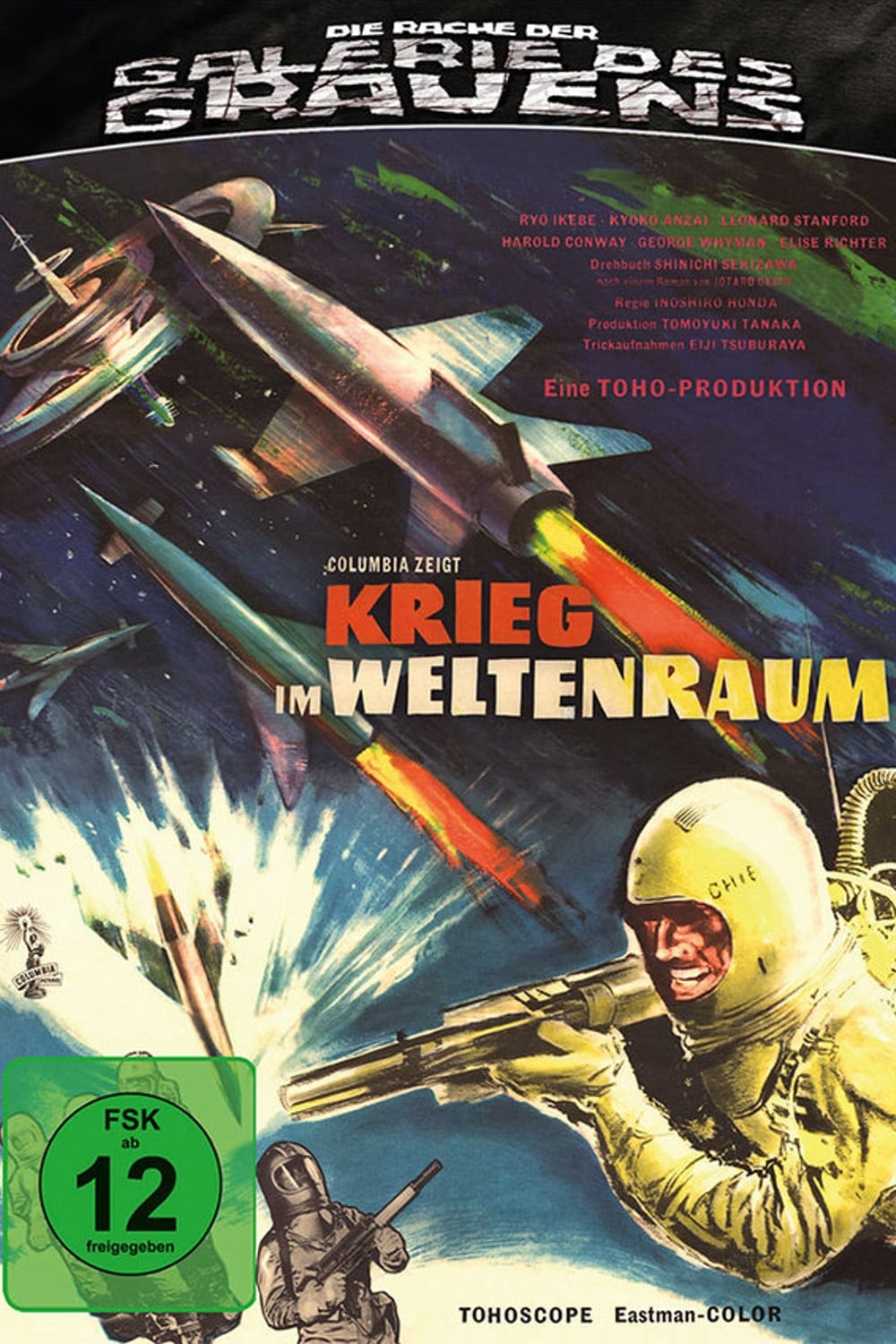
Although there is no real mention of the previous film "Chikyu Boeigun" in the screenplay, or can I locate an explanation by either Tomoyuki Tanaka, or Toho Studios, in general, to consider it as such. "Uchu Daisenso" is always referred too as a sequel to the 1957 production.
I can speculate that story writer Jojiro Okami worked off his open ended previous story line. Keeping the aliens still as the survivors of "Mysteroid Planet #5", because after loosing that first battle with the "Earth Defense Forces". We know that some of them survived and the audience had never viewed "The Mysterians" Moon Base mentioned by "Dr. Adashi". Which could logically have been untouched and after eight years they could have reorganized. Okami's original story might have been modified when turned into a screenplay by Shininchi Sekizawa..
WAKUSEI DAISENSO ZA UO IN SUPESU (PLANETARY GREAT WAR aka: GREAT PLANET WAR: THE WAR IN SPACE)
Eighteen years later Toho Studio announced a sequel to 1959's "Uchu Daisenso". There was no question the proposed motion picture was inspired by the success of George Lucas' "Star Wars". That was released originally in the United States on May 25, 1977 and reached Japan, officially, on June 30, 1978.
"Wakusei Daisenso Za uo in Supesu" was released in Japan on December 17, 1977.|

The motion picture was Co-Produced by Tomoyuki Tanaka and Fumio Tanaka (No relation to Tomoyuki). Fumio Tanaka was a novelist known by the pen names of Mitsuru Takihara and Keiichiro Kusanagi. He joined Toho Studios in 1964 and among his work Fumio Produced 1970's "Yurei yashiki no kyofu: Chi wo su ningyo (A Fear of a Haunted House: A Doll Sucking Blood" aka: "A Vampire Doll)". 1971's "Noroi no yakata-Chi o su me (House of Curses-Eye Sucking Blood" aka: "Lake of Dracula)" and 1974's "Chi o suu bara (Blood Sucking Rose" aka: "Evil of Dracula)".
The Director of "Wakusei Daisenso Za uo in Supesu" was Jun Fukuda. For fans of the Showa Era "Gojira/Godzilla" franchise. Fukuda directed the following "Gojira, Ebira, Mosura Nankai no Daiketto (Godzilla-Ebira-Mothra Great Duel of the South Sea)", "Kaiju-to no Kessen: Gojira no Musuko (Son of Godzilla at a decisive battle of Monster Island)", Chikyu kogeki meirei: Gojira tai Gaigan (Earth Attack Command: Godzilla vs Gigan)", "Gojira tai Megaro (Godzilla vs Megalon)" and "Gojira tai Mekagojira (Godzila vs Mechgodzilla)".
Special Effects for this production were by Teruyoshi Nakano. Nakano has been the Special Effects Assistant on many films for Eiji Tsuburaya. Among them "Hawi Middouei daikaikusen: Taiheiiyo no arashi (Hawaii-Midway Battle of the Sea and Sky: Storm in the Pacific Ocean aka: Storm Over the Pacific)", "Kingu KonguTai Gojira (King Kong vs Godzilla)", "Kaitei Gunkan (Undersea Warship aka: Atragon)" and "Sandai Kaiju: Chikyu Saidai no Kessen (The Three Great Monsters: The Greatest Decisive Battle on Earth aka: Ghidrah, the Three Headed Monster)".
There were two screenplay writers, but there is confusion over the first screenplay writer's name. He was either Shuichi Nagahara. Who only has five violent dramas to his credit and not one Science Fiction entry, or he was Hideichi Nagahara. Who has 27 features to his credit including this picture . Along with the original screenplay for the 1984 Toho remake of "Gojira" and is listed as contributor to the English version with Raymond Burr "Godzilla 1985". I could not find any information to confirm that these two writers are actually the same person. Depending on the site for "Wakusei Daisenso Za uo in Supesu" both names are interchanged leading me to suspect they are the same person
The other writer was Ryuzo Nakanishi. Who has 62 writing credits that include all five of Shuichi Nagahara's films as co-writer. However, this appears to be his only Science Fiction film.
Although there is the "Star Wars" influence. The screenplay by Nagahara and Nakanishi is more a re-imagining, than a remake, of Toho Studio's 1963's "Kaitei Gunkan (Undersea Warship aka: Atragon)". Along with "Lifts" from the 1957 and 1959 Toho Space Operas. Combined with a story line seen in Academy Productions and Group TAC's 1974 animated series "Uchu Senkan Yamato (Space Battleship Yamato)".
Brief summary of 1963's plot:
The Undersea Kingdom of Mu attacks the surface world. It is discovered that "Captain Hachiro Jinguji" is alive and did not die at the end of World War 2. In fact he and his crew live on a remote island and have constructed the "Gotengo". A flying submarine that can drill into the Earth. The United Nations wants "Captain Junguji" to use his creation to stop the Mu Empire. He refuses until his daughter "Makoto" is kidnapped by an agent of Mu. Along with a photographer, "Susumu Hatanaka", who has fallen in love with "Makoto", they lead both an attack and rescue operation to the Undersea Kingdom.
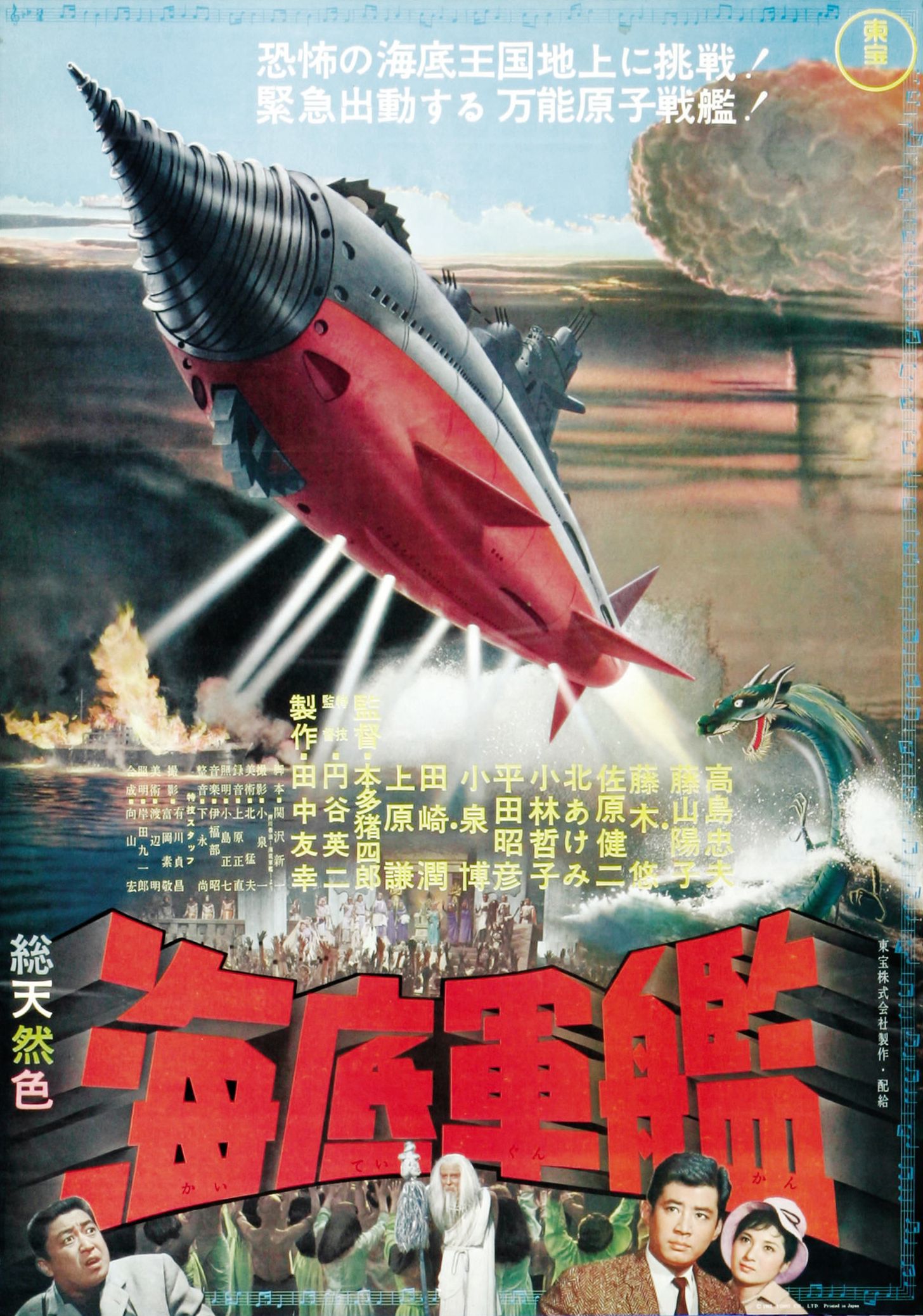
One of the very obvious "Lifts" from "Kaitei Gunkan" and "Uchu Senkan Yamato". is in the design of the "United Nations Space Federation's Gohten". Which appears as a hybrid of the "Gotengo" and the "Yamato".

Below the "Gotengo" in "Kaitei Gunkan":

Below the "Yamato" in "Uchu Senkan Yamato":
The "Gohten" in "Wakusei Daisenso Za uo in Supesu" with visible attributes from both craft.

As to how the screenplay ties this story with the 1959 production?
Unlike the first two Toho features with similar named characters. There are no similar names in this production. In "Chikyu Boeigun" most of the action revolves around the "Japanese Defense Force". Who asks for other countries to assist and creates the title "Earth Defense Forces", but this is not explained to be connected in anyway to the "United Nations". There is no reference in "Uchu Daisenso" to that originally named group, but the action now revolves around the "United Nations Space Command". Which apparently was established some time in the past. Could it be just the progression of the "Earth Defense Forces"? We do not know. While in "Wakusei Daisenso Za uo in Supesu" we now have the "United Nations Space Federation". The utilization of the U.N. is really the only way to consider this picture a sequel.
The cast was headed by:
Kensaku Morita portraying "Koji Miyoshi" the Duty Officer of the United Nations Space Bureau. Think "Susumu Hatananaka" in "Kaitei Gunkan". Morita appeared in 28 features between 1969 and 2006. One of which was 1980's "Fukkatsu no hi (Resurrection Day)". The Science Fiction film was about a "Virus", U.S. title, that kills off most of the world's population. The original Japanese film ran 156 minutes. It was cut to 108 minutes for U.S. theatrical run and to 93 minutes for U.S. television.
Yuko Asano was "Jun Takigawa" of the United Nations. Think "Makoto Jinguji" in "Kaitei Gunkan". Between 1971 and 2017 Asano appeared in 84 Japanese productions.
Ryo Ikebe from "Uchu Daisenso" now portrays "Masato Takigawa", "Jun's" father, Doctor of Space Engineering and Commander of the GOHTEN. Think "Captain Hachiro Jinguji" in "Kaitei Gunkan".
Masaya Oki portrayed "Reisuke Muroi" Flight Instructor, Japan Air Self Defense Force. Between 1968 and 1983 Oki appeared in 31 films. In 1980 he was a voice actor in the role of "Keith Anyan" in the anime "Tera e,,,, (Toward the Terra)". Based upon a popular Science Fiction manga turned first into a feature film and then a 24 episode animated series.
Akikhiko Hirata from "Chikyu Boeigun" now portrays "Commander Oishi" of the Japan Defense Force.
William Ross portrayed "Dr Schmidt" and also the alien "Hell Commander". As an actor American Ross appeared in 30 films including "The Green Slime", the Robert Mitchum picture "The Yakuza", the Richard Boone movie "The Last Dinosaur" and "Resurrection Day".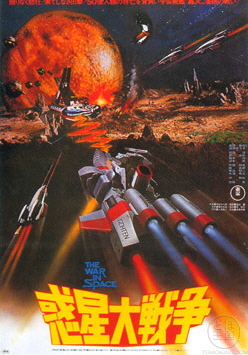
THE PLOT
The story opens in 1988 and begins with what is believed to be a comet scare. As many pass very close to the Earth, but do not actually hit. Later it will be discovered that the "Comets" are in reality alien "Hell Fighters".
There is now electromagnetic interference around the globe. Next contact with Space Station Terra is lost. This is followed by sightings of UFO's all over the World and "Dr. Schmidt" investigates for the United Nations. Meanwhile, the Space Station crew manages to get a report out of a large "Roman Galleon" appearing and electronic signals coming from Venus. Then communication is once more lost as the station is destroyed. The galleon is called the "Daimakan" and before you ask. Toei Company's "Uchu kara no Messeji (Message from Outer Space) wasn't released until April 29, 1978 in Japan.
U.N. Team Leader "Koji Miyoshi" goes to visit "Professor Masato Takigawa" to inform him that the United Nations wants "Takigawa" to complete the construction of his space defense unit called "Gohten". He refuses saying the project was disbanded three years ago after the fear of an alien invasion was unproven. This is followed by a call to "Masato Takigawa" from the Japanese branch of the United Nations Space Bureau. He is informed that "Dr. Schmidt" was killed while investigating the UFO's. This still does not change "Masato Takigawa's" mind set.
A secondary plot line with a slight variation from "Kaitei Gunkan". Has "Koji Miyoshi" in love with "Jun Takigawa", but "Jun" is engaged to be married to "Reisuke Muroi".
So who are the aliens?
In "Chikyu Boeigun" they are the survivors of "Mysteroid Planet #5". Who moved first to Mars and then established a base on the Moon to attack Earth. They have a plan to mate with Earth women and save their dying civilization. In "Uchu Daisenso" the aliens are from the unknown planet "Natarl". What their background might be, or "Natarl's" location is never mentioned. While in "Wakusei Daisenso Za uo in Supesu" the aliens are closer to those in the 1957 motion picture. As far as a back story is concerned.
They come from "Messiah 13, the Third Planet of the Yomi System". The solar system is located 22,000 light years from Earth's "Milky Way" Galaxy. Like Earth the alien's planet is the third from their sun, but the people are dying out and they need a planet as close to their own to conqueror and women to mate with. Called "The Messiah 13" this warrior race establishes a base of operations on Venus.
An interesting choice when one thinks that by 1977 it was clear that Venus had a toxic environment and the aliens are being compared to human beings. The film, of course, is a throw back to the 1950's Toho motion pictures and those American and U,K. Science Fiction titles of that decade.
My article on "Invaders from Mars and Venus" during the 1950's can be read at:
http://www.bewaretheblog.com/2015/07/invaders-from-mars-except-when-they.html
Returning to the plot. The supposed dead "Dr, Schmidt" turns up alive. With "Koji Miyoshi", "Reisuke Muroi" and another the four drive up to "Masato Takigawa's" house. Where "Dr. Schmidt" tells him he must finish the "Gohten". However, "Takigawa" realizes the man is an impostor as he is using his right hand and the real "Dr. Schmidt" was left handed. The man runs out of the house and a chase begins, but cornered the impostor blows himself up. It is revealed that he is a "Messiah 13" alien wearing a plastic mask.
Three things now happen. The United Nations place "Commander Oishi" in charge of the defense if the planet. "Masato Takigawa" is ordered to complete the "Gohten" and the alien base on Venus is discovered.
The "Messiah 13" launch a full scale attack on New York City, London, Paris, Moscow and San Francisco. The "Gohten Team" now takes a submarine to an island where the ship is housed and construction needs to be finished.
The UFO's start an attack on the island, but the "Gohten" is completed and launched with a full crew compliment. It takes out the UFO's and proceeds toward Outer Space and Venus.

In space the "Gohten" finds the body of one of the crewmen of the space station and brings it on board. The body turns out to be a "Messiah 13 Alien" and he kidnaps "Jun". He takes her to "Commander Hell". the self proclaimed Emperor of the Galaxy on the "Daimakan". Contact is made with the "Gohten" and the "Commander" explains why the Earth has been targeted.
.jpg)
The "Gohten" continues toward Venus. Below "Jun" is a prisoner under the watchful eyes of the "Beastman" on the Space Galleon.

"Jun" is taken to the Venus base and a lander from the "Gohten" has located the "Daimakan" in a cave with a force field around it. Returning to their ship with pictures taken of the "Roman Galleon" a plan is made.
A discovery is made of an air duct leading to the "Messiah 13" underground base. It presents one means of entry. A multi-part battle now takes place. The lander is reused with a larger party and they enter the "Daimakan" in an attempt to destroy it. The space fighters are launched to try and take down the Force Field and engage in battle with the UFO's. Through the air duct "Reisuke Muroi" and others enter the Venus base and "Muroi" is killed. "Jun" is rescued by "Koji Miyoshi", but first he fights the "Beastman".

The "Gohten" and the "Daimakan" now engage is aerial combat and it appears the former is winning. Suddenly a high energy beam canon on the "Daimakan" opens up on the "Gohten" sending the Earth ship crashing to the Venusian surface.
While the crew is repairing the space craft "Tagigawa" goes into the "Gohten's" drill-bow. He has been hiding a secret from everyone else. "Jun" and "Koji" return to the control room after checking on the repairs. They find her father missing, but a tape recording left my him. On it they find out the reason he was refusing to finish the"Gohten" and why the "Messiah 13" aliens' were so interested in both his ship and the inventor. He had discovered a way to make a bomb so powerful it could destroy an entire planet.
"Jun's" father has detached the drill-bow and is flying it at the "Daimakan". As the repaired "Gohten" lifts off the surface of Venus. "Masato Takigawa" crashes the "Gohten's drill-bow into the "Daimakan" causing that craft to fall into a volcano. That action in turn starts a chain reaction across Venus. As the "Gohten" moves toward Earth the entire planet of Venus blows up.
The motion picture was never released theatrically in the United States. Although a DVD was finally released on A[ril 25, 2006. On line, at the time of this writing, a new copy costs $129 and the average used copy is $50.
The film did finally appear on syndicated American television. Here is the poster promoting that release.

Additionally depending on where the English language dub by Toho International played. The title was not only "War in Space", but "Battle in Outer Space 2", "Cosmos" and "Planet Wars".
Below is a poster for "Wakusei Daisenso Za uo in Supesu" from Indonesia. Talk about playing off of "Star Wars". Notice that they use the names of American actors William Ross and David Perin to hide the fact the picture, even dubbed, is from Japan with a primarily Japanese cast.

Below is the France poster for the film:

In Demark this was the poster:

Depending on how my reader defines "TRILOGY"! Will determine to them, if "Chikyu Boeigun", "Uchu Daisenso" and "Wakusei Daisenso Za uo in Supesu" fit that word.
France

West Germany

Although there is no real mention of the previous film "Chikyu Boeigun" in the screenplay, or can I locate an explanation by either Tomoyuki Tanaka, or Toho Studios, in general, to consider it as such. "Uchu Daisenso" is always referred too as a sequel to the 1957 production.
I can speculate that story writer Jojiro Okami worked off his open ended previous story line. Keeping the aliens still as the survivors of "Mysteroid Planet #5", because after loosing that first battle with the "Earth Defense Forces". We know that some of them survived and the audience had never viewed "The Mysterians" Moon Base mentioned by "Dr. Adashi". Which could logically have been untouched and after eight years they could have reorganized. Okami's original story might have been modified when turned into a screenplay by Shininchi Sekizawa..
WAKUSEI DAISENSO ZA UO IN SUPESU (PLANETARY GREAT WAR aka: GREAT PLANET WAR: THE WAR IN SPACE)
Eighteen years later Toho Studio announced a sequel to 1959's "Uchu Daisenso". There was no question the proposed motion picture was inspired by the success of George Lucas' "Star Wars". That was released originally in the United States on May 25, 1977 and reached Japan, officially, on June 30, 1978.
"Wakusei Daisenso Za uo in Supesu" was released in Japan on December 17, 1977.|

The motion picture was Co-Produced by Tomoyuki Tanaka and Fumio Tanaka (No relation to Tomoyuki). Fumio Tanaka was a novelist known by the pen names of Mitsuru Takihara and Keiichiro Kusanagi. He joined Toho Studios in 1964 and among his work Fumio Produced 1970's "Yurei yashiki no kyofu: Chi wo su ningyo (A Fear of a Haunted House: A Doll Sucking Blood" aka: "A Vampire Doll)". 1971's "Noroi no yakata-Chi o su me (House of Curses-Eye Sucking Blood" aka: "Lake of Dracula)" and 1974's "Chi o suu bara (Blood Sucking Rose" aka: "Evil of Dracula)".
The Director of "Wakusei Daisenso Za uo in Supesu" was Jun Fukuda. For fans of the Showa Era "Gojira/Godzilla" franchise. Fukuda directed the following "Gojira, Ebira, Mosura Nankai no Daiketto (Godzilla-Ebira-Mothra Great Duel of the South Sea)", "Kaiju-to no Kessen: Gojira no Musuko (Son of Godzilla at a decisive battle of Monster Island)", Chikyu kogeki meirei: Gojira tai Gaigan (Earth Attack Command: Godzilla vs Gigan)", "Gojira tai Megaro (Godzilla vs Megalon)" and "Gojira tai Mekagojira (Godzila vs Mechgodzilla)".
Special Effects for this production were by Teruyoshi Nakano. Nakano has been the Special Effects Assistant on many films for Eiji Tsuburaya. Among them "Hawi Middouei daikaikusen: Taiheiiyo no arashi (Hawaii-Midway Battle of the Sea and Sky: Storm in the Pacific Ocean aka: Storm Over the Pacific)", "Kingu KonguTai Gojira (King Kong vs Godzilla)", "Kaitei Gunkan (Undersea Warship aka: Atragon)" and "Sandai Kaiju: Chikyu Saidai no Kessen (The Three Great Monsters: The Greatest Decisive Battle on Earth aka: Ghidrah, the Three Headed Monster)".
There were two screenplay writers, but there is confusion over the first screenplay writer's name. He was either Shuichi Nagahara. Who only has five violent dramas to his credit and not one Science Fiction entry, or he was Hideichi Nagahara. Who has 27 features to his credit including this picture . Along with the original screenplay for the 1984 Toho remake of "Gojira" and is listed as contributor to the English version with Raymond Burr "Godzilla 1985". I could not find any information to confirm that these two writers are actually the same person. Depending on the site for "Wakusei Daisenso Za uo in Supesu" both names are interchanged leading me to suspect they are the same person
The other writer was Ryuzo Nakanishi. Who has 62 writing credits that include all five of Shuichi Nagahara's films as co-writer. However, this appears to be his only Science Fiction film.
Although there is the "Star Wars" influence. The screenplay by Nagahara and Nakanishi is more a re-imagining, than a remake, of Toho Studio's 1963's "Kaitei Gunkan (Undersea Warship aka: Atragon)". Along with "Lifts" from the 1957 and 1959 Toho Space Operas. Combined with a story line seen in Academy Productions and Group TAC's 1974 animated series "Uchu Senkan Yamato (Space Battleship Yamato)".
Brief summary of 1963's plot:
The Undersea Kingdom of Mu attacks the surface world. It is discovered that "Captain Hachiro Jinguji" is alive and did not die at the end of World War 2. In fact he and his crew live on a remote island and have constructed the "Gotengo". A flying submarine that can drill into the Earth. The United Nations wants "Captain Junguji" to use his creation to stop the Mu Empire. He refuses until his daughter "Makoto" is kidnapped by an agent of Mu. Along with a photographer, "Susumu Hatanaka", who has fallen in love with "Makoto", they lead both an attack and rescue operation to the Undersea Kingdom.

One of the very obvious "Lifts" from "Kaitei Gunkan" and "Uchu Senkan Yamato". is in the design of the "United Nations Space Federation's Gohten". Which appears as a hybrid of the "Gotengo" and the "Yamato".

Below the "Gotengo" in "Kaitei Gunkan":

Below the "Yamato" in "Uchu Senkan Yamato":

The "Gohten" in "Wakusei Daisenso Za uo in Supesu" with visible attributes from both craft.

As to how the screenplay ties this story with the 1959 production?
Unlike the first two Toho features with similar named characters. There are no similar names in this production. In "Chikyu Boeigun" most of the action revolves around the "Japanese Defense Force". Who asks for other countries to assist and creates the title "Earth Defense Forces", but this is not explained to be connected in anyway to the "United Nations". There is no reference in "Uchu Daisenso" to that originally named group, but the action now revolves around the "United Nations Space Command". Which apparently was established some time in the past. Could it be just the progression of the "Earth Defense Forces"? We do not know. While in "Wakusei Daisenso Za uo in Supesu" we now have the "United Nations Space Federation". The utilization of the U.N. is really the only way to consider this picture a sequel.
The cast was headed by:
Kensaku Morita portraying "Koji Miyoshi" the Duty Officer of the United Nations Space Bureau. Think "Susumu Hatananaka" in "Kaitei Gunkan". Morita appeared in 28 features between 1969 and 2006. One of which was 1980's "Fukkatsu no hi (Resurrection Day)". The Science Fiction film was about a "Virus", U.S. title, that kills off most of the world's population. The original Japanese film ran 156 minutes. It was cut to 108 minutes for U.S. theatrical run and to 93 minutes for U.S. television.
Yuko Asano was "Jun Takigawa" of the United Nations. Think "Makoto Jinguji" in "Kaitei Gunkan". Between 1971 and 2017 Asano appeared in 84 Japanese productions.
Ryo Ikebe from "Uchu Daisenso" now portrays "Masato Takigawa", "Jun's" father, Doctor of Space Engineering and Commander of the GOHTEN. Think "Captain Hachiro Jinguji" in "Kaitei Gunkan".
Masaya Oki portrayed "Reisuke Muroi" Flight Instructor, Japan Air Self Defense Force. Between 1968 and 1983 Oki appeared in 31 films. In 1980 he was a voice actor in the role of "Keith Anyan" in the anime "Tera e,,,, (Toward the Terra)". Based upon a popular Science Fiction manga turned first into a feature film and then a 24 episode animated series.
Akikhiko Hirata from "Chikyu Boeigun" now portrays "Commander Oishi" of the Japan Defense Force.
William Ross portrayed "Dr Schmidt" and also the alien "Hell Commander". As an actor American Ross appeared in 30 films including "The Green Slime", the Robert Mitchum picture "The Yakuza", the Richard Boone movie "The Last Dinosaur" and "Resurrection Day".

THE PLOT
The story opens in 1988 and begins with what is believed to be a comet scare. As many pass very close to the Earth, but do not actually hit. Later it will be discovered that the "Comets" are in reality alien "Hell Fighters".
There is now electromagnetic interference around the globe. Next contact with Space Station Terra is lost. This is followed by sightings of UFO's all over the World and "Dr. Schmidt" investigates for the United Nations. Meanwhile, the Space Station crew manages to get a report out of a large "Roman Galleon" appearing and electronic signals coming from Venus. Then communication is once more lost as the station is destroyed. The galleon is called the "Daimakan" and before you ask. Toei Company's "Uchu kara no Messeji (Message from Outer Space) wasn't released until April 29, 1978 in Japan.
U.N. Team Leader "Koji Miyoshi" goes to visit "Professor Masato Takigawa" to inform him that the United Nations wants "Takigawa" to complete the construction of his space defense unit called "Gohten". He refuses saying the project was disbanded three years ago after the fear of an alien invasion was unproven. This is followed by a call to "Masato Takigawa" from the Japanese branch of the United Nations Space Bureau. He is informed that "Dr. Schmidt" was killed while investigating the UFO's. This still does not change "Masato Takigawa's" mind set.
A secondary plot line with a slight variation from "Kaitei Gunkan". Has "Koji Miyoshi" in love with "Jun Takigawa", but "Jun" is engaged to be married to "Reisuke Muroi".
So who are the aliens?
In "Chikyu Boeigun" they are the survivors of "Mysteroid Planet #5". Who moved first to Mars and then established a base on the Moon to attack Earth. They have a plan to mate with Earth women and save their dying civilization. In "Uchu Daisenso" the aliens are from the unknown planet "Natarl". What their background might be, or "Natarl's" location is never mentioned. While in "Wakusei Daisenso Za uo in Supesu" the aliens are closer to those in the 1957 motion picture. As far as a back story is concerned.
They come from "Messiah 13, the Third Planet of the Yomi System". The solar system is located 22,000 light years from Earth's "Milky Way" Galaxy. Like Earth the alien's planet is the third from their sun, but the people are dying out and they need a planet as close to their own to conqueror and women to mate with. Called "The Messiah 13" this warrior race establishes a base of operations on Venus.
An interesting choice when one thinks that by 1977 it was clear that Venus had a toxic environment and the aliens are being compared to human beings. The film, of course, is a throw back to the 1950's Toho motion pictures and those American and U,K. Science Fiction titles of that decade.
My article on "Invaders from Mars and Venus" during the 1950's can be read at:
http://www.bewaretheblog.com/2015/07/invaders-from-mars-except-when-they.html
Returning to the plot. The supposed dead "Dr, Schmidt" turns up alive. With "Koji Miyoshi", "Reisuke Muroi" and another the four drive up to "Masato Takigawa's" house. Where "Dr. Schmidt" tells him he must finish the "Gohten". However, "Takigawa" realizes the man is an impostor as he is using his right hand and the real "Dr. Schmidt" was left handed. The man runs out of the house and a chase begins, but cornered the impostor blows himself up. It is revealed that he is a "Messiah 13" alien wearing a plastic mask.
Three things now happen. The United Nations place "Commander Oishi" in charge of the defense if the planet. "Masato Takigawa" is ordered to complete the "Gohten" and the alien base on Venus is discovered.
The "Messiah 13" launch a full scale attack on New York City, London, Paris, Moscow and San Francisco. The "Gohten Team" now takes a submarine to an island where the ship is housed and construction needs to be finished.
The UFO's start an attack on the island, but the "Gohten" is completed and launched with a full crew compliment. It takes out the UFO's and proceeds toward Outer Space and Venus.

In space the "Gohten" finds the body of one of the crewmen of the space station and brings it on board. The body turns out to be a "Messiah 13 Alien" and he kidnaps "Jun". He takes her to "Commander Hell". the self proclaimed Emperor of the Galaxy on the "Daimakan". Contact is made with the "Gohten" and the "Commander" explains why the Earth has been targeted.
.jpg)
The "Gohten" continues toward Venus. Below "Jun" is a prisoner under the watchful eyes of the "Beastman" on the Space Galleon.

"Jun" is taken to the Venus base and a lander from the "Gohten" has located the "Daimakan" in a cave with a force field around it. Returning to their ship with pictures taken of the "Roman Galleon" a plan is made.
A discovery is made of an air duct leading to the "Messiah 13" underground base. It presents one means of entry. A multi-part battle now takes place. The lander is reused with a larger party and they enter the "Daimakan" in an attempt to destroy it. The space fighters are launched to try and take down the Force Field and engage in battle with the UFO's. Through the air duct "Reisuke Muroi" and others enter the Venus base and "Muroi" is killed. "Jun" is rescued by "Koji Miyoshi", but first he fights the "Beastman".

The "Gohten" and the "Daimakan" now engage is aerial combat and it appears the former is winning. Suddenly a high energy beam canon on the "Daimakan" opens up on the "Gohten" sending the Earth ship crashing to the Venusian surface.
While the crew is repairing the space craft "Tagigawa" goes into the "Gohten's" drill-bow. He has been hiding a secret from everyone else. "Jun" and "Koji" return to the control room after checking on the repairs. They find her father missing, but a tape recording left my him. On it they find out the reason he was refusing to finish the"Gohten" and why the "Messiah 13" aliens' were so interested in both his ship and the inventor. He had discovered a way to make a bomb so powerful it could destroy an entire planet.
"Jun's" father has detached the drill-bow and is flying it at the "Daimakan". As the repaired "Gohten" lifts off the surface of Venus. "Masato Takigawa" crashes the "Gohten's drill-bow into the "Daimakan" causing that craft to fall into a volcano. That action in turn starts a chain reaction across Venus. As the "Gohten" moves toward Earth the entire planet of Venus blows up.
The motion picture was never released theatrically in the United States. Although a DVD was finally released on A[ril 25, 2006. On line, at the time of this writing, a new copy costs $129 and the average used copy is $50.
The film did finally appear on syndicated American television. Here is the poster promoting that release.

Additionally depending on where the English language dub by Toho International played. The title was not only "War in Space", but "Battle in Outer Space 2", "Cosmos" and "Planet Wars".
Below is a poster for "Wakusei Daisenso Za uo in Supesu" from Indonesia. Talk about playing off of "Star Wars". Notice that they use the names of American actors William Ross and David Perin to hide the fact the picture, even dubbed, is from Japan with a primarily Japanese cast.

Below is the France poster for the film:

In Demark this was the poster:
Depending on how my reader defines "TRILOGY"! Will determine to them, if "Chikyu Boeigun", "Uchu Daisenso" and "Wakusei Daisenso Za uo in Supesu" fit that word.





No comments:
Post a Comment